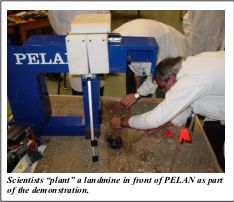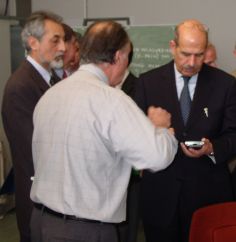|
by Phillip Womble (some material contributed by Dr. M. Samiei of
IAEA)
 The PELAN
system for explosives detection was purchased by the International
Atomic Energy Agency (IAEA). The IAEA’s goal is to use nuclear
techniques to find abandoned landmines—landmines that are still
dangerous years or decades after the conflict is over. The PELAN
system for explosives detection was purchased by the International
Atomic Energy Agency (IAEA). The IAEA’s goal is to use nuclear
techniques to find abandoned landmines—landmines that are still
dangerous years or decades after the conflict is over.
The PELAN was selected by a group of international experts from
numerous nuclear-based techniques as the most promising nuclear sensor
for landmine detection. In 2001, the IAEA started a project with one
goal: to optimize the PELAN for humanitarian de-mining.
PELAN uses neutrons to detect explosives. The neutrons interact
with the materials in the soil and the resulting gamma rays indicate
what elements are present. The gamma rays can also indicate how much
of an element is in the soil. Explosives are composed of hydrogen,
carbon, nitrogen, and oxygen but the relative amounts of these
elements is quite different in explosives when compared to innocuous
materials. WKU professor George Vourvopoulos invented PELAN. Since
1998, he and Dr. Phil Womble have been developing applications based
on the PELAN technology. WKU alumni, Jon Paschal plays a major role in
the PELAN development by creating software and electronic systems.
 In February
2002, the IAEA demonstrated PELAN at briefings organized for invited
experts from organizations engaged in demining efforts in affected
countries, to familiarize them with its capabilities and development.
Demonstrations and project briefings also were held for Vienna-based
staff from Member States having Permanent Missions to the IAEA,
including a session attended by the Agency's Director General Mohamed
El Baradei. In February
2002, the IAEA demonstrated PELAN at briefings organized for invited
experts from organizations engaged in demining efforts in affected
countries, to familiarize them with its capabilities and development.
Demonstrations and project briefings also were held for Vienna-based
staff from Member States having Permanent Missions to the IAEA,
including a session attended by the Agency's Director General Mohamed
El Baradei.
Several IAEA Member States are requesting initiation of a project
for field-testing and demonstration of the suitability of a pulsed
neutron probe method for humanitarian de-mining. The USA already has
provided $212,000 for the purchase of PELAN, and the IAEA now is
evaluating proposals from leading laboratories in the USA, Russia, and
European Union for optimizing the instrument. Once the instrument is
more fully developed and tested under field conditions, it can become
an important complementary instrument in a de-miner's kit to help
teams probing for landmines find the explosives before they injure or
kill more people.
A website with a video is located at
http://www.iaea.org/worldatom/Press/News/landmines.shtml.
|
